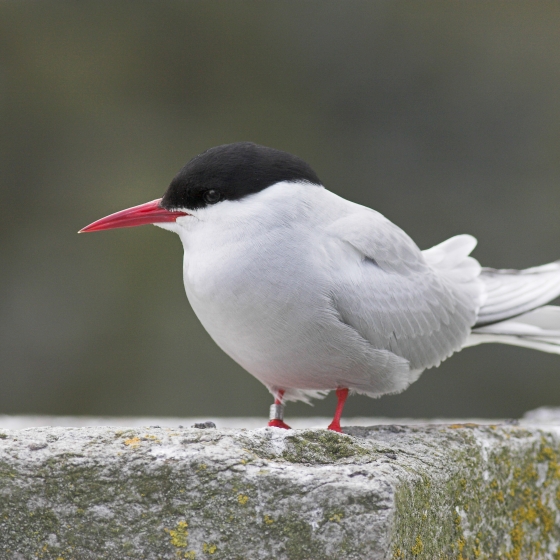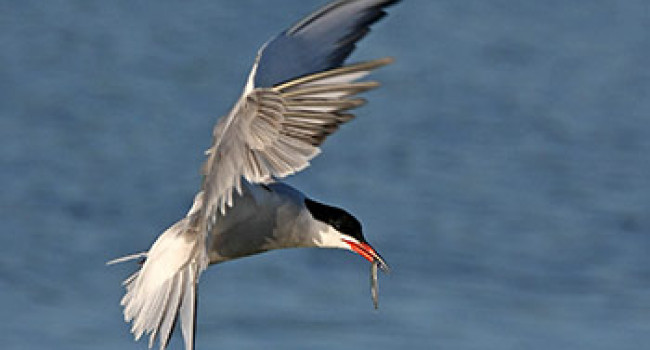Arctic Tern
Sterna paradisaea (Pontoppidan, 1763)
AE
 ARCTE
ARCTE  6160
6160

Family: Charadriiformes > Laridae

Arctic Terns are more oceanic than most terns, and have the longest migrations of any. Though very similar to Common Tern, Arctic Tern is noticeably more graceful in flight.
Breeding at high latitudes in the Arctic and then travelling south in time for another summer in the Antarctic, some Arctic Terns experience more daylight than any other species. Feeding and nest defence, and a potential lifespan of three decades, add greatly to their extraordinary air miles. In the far south they patrol the edge of pack ice, often resting on ice floes, and also feed in the open ocean, sometimes around Antarctic Minke Whales.
Breeding in Britain is exclusively coastal and mainly in the north, with the highest numbers in the Western Isles, Orkney and Shetland. Migration is mainly offshore or coastal, though hundreds cross Britain from the Atlantic to the North Sea each spring and may pause at lakes and reservoirs.
Identification
Arctic Tern identification is often difficult. The following article may help when identifying Arctic Tern.
SONGS AND CALLS
Listen to example recordings of the main vocalisations of Arctic Tern, provided by xeno-canto contributors.
Young call
Flight call
Alarm call
Call
Develop your bird ID skills with our training courses
Our interactive online courses are a great way to develop your bird identification skills, whether you're new to the hobby or a competent birder looking to hone your abilities.
Browse training coursesStatus and Trends
Population size and trends and patterns of distribution based on BTO surveys and atlases with data collected by BTO volunteers.
CONSERVATION STATUS
This species can be found on the following statutory and conservation listings and schedules.
POPULATION CHANGE
Census data suggest that Arctic Tern numbers increased by 50% between 1969–70 and 1985–88, but then declined by 31% by the time of the Seabird 2000 Census (1998–2002). However, there is some uncertainty around the initial estimate and hence the reliability of the apparent initial populaion increases. Results from the more recent Seabirds Count (2015–2021) are not yet available but annual monitoring data suggest that the population has remained relatively stable since Seabird 2000, although further declines may have occurred in Scotland (JNCC 2022).
DISTRIBUTION
Arctic Terns breed predominantly in coastal areas of Scotland and Ireland, with major colonies found in Shetland and Orkney. In Wales they are restricted to the islands off Anglesey, and there is a small colony on the Isle of Man. Breeding colonies in Ireland are located in five main clusters.
Occupied 10-km squares in UK
| No. occupied in breeding season | 294 |
| % occupied in breeding season | 9.7 |
| No. occupied in winter | 54 |
| % occupied in winter | 1.8 |
European Distribution Map
DISTRIBUTION CHANGE
Arctic Tern breeding range has contracted by 31% since the 1968–72 Breeding Atlas. Losses are greatest in western Scotland, where predation by American Mink has been implicated, and in eastern Scotland, where food shortages have resulted in very low breeding productivity.
Change in occupied 10-km squares in the UK
| % change in range in breeding season (1968–72 to 2008–11) | -30.5% |
| % change in range in winter (1981–84 to 2007–11) | +1400% |
SEASONALITY
Arctic Tern is a summer breeding species, arriving from April/May onwards and sometimes lingering into late autumn.

Movement
Information about movement and migration based on online bird portals (e.g. BirdTrack), Ringing schemes and tracking studies.
RINGING RECOVERIES
View a summary of recoveries in the Online Ringing Report.
Foreign locations of birds ringed or recovered in Britain & Ireland

Biology
Lifecycle and body size information about Arctic Tern, including statistics on nesting, eggs and lifespan based on BTO ringing and nest recording data.
SURVIVAL & LONGEVITY
View number ringed each year in the Online Ringing Report
Maximum Age from Ringing 
|
31 years 0 months 18 days (set in 2012) 
|
Typical Lifespan 
|
13 years with breeding typically at 4 year |
Adult Survival 
|
0.9  
|
BIOMETRICS
Wing Length 
|
Adults | 272.7±7.6 | Range 262–286mm, N=263 |
| Juveniles | 245.9±18.6 | Range 228-263mm, N=30 |
Body Weight 
|
Adults | 104±9 | Range 90.5–119g, N=221 |
| Juveniles | 106±7.6 | Range 92.0–118g, N=30 |
Feather measurements and photos on featherbase 
CODES & CLASSIFICATION
Ring size 
|
C2 |
Field Codes 
|
2-letter: AE | 5-letter code: ARCTE | Euring: 6160 |
For information in another language (where available) click on a linked name
Research
Interpretation and scientific publications about Arctic Tern from BTO scientists.
CAUSES AND SOLUTIONS
Causes of change
There is good evidence that the declines in the Arctic Tern population between 1988 and 2004 are likely to have been driven, at least partly, by low breeding productivity which was related to changes in sandeel populations (Ewins 1985, Monaghan et al. 1989, Suddaby & Ratcliffe 1997). Climate change is believed to have played a role by driving the warming of UK waters thus affecting sandeel abundance (Wright & Bailey 1993).
Links to more studies from ConservationEvidence.com
- Effectiveness of disturbance methods and egg removal to deter large gulls Larus spp. from competing with nesting terns Sterna spp. on Coquet Island RSPB reserve, Northumberland, England
- Calcium supplementation of breeding birds: directions for future research
- Rotator for protecting circular fish ponds against predatory birds
Read more studies about Arctic Tern on Conservation Evidence >
Would you like to search for another species?












Share this page